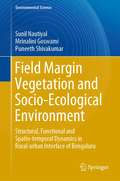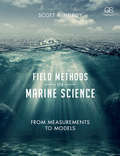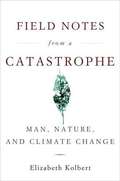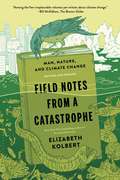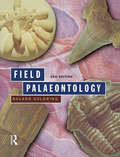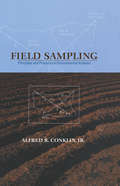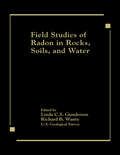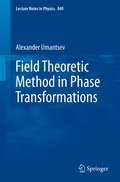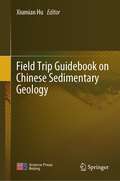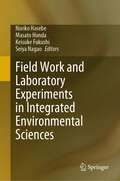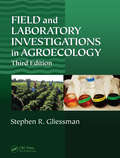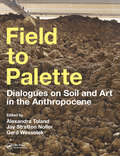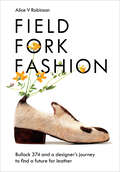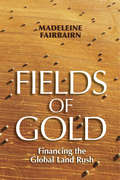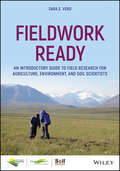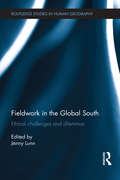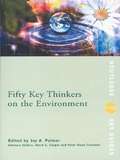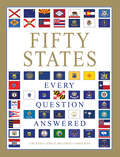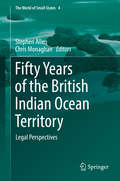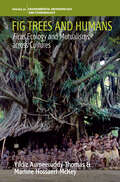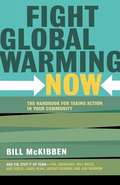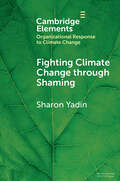- Table View
- List View
Field Margin Vegetation and Socio-Ecological Environment: Structural, Functional and Spatio-temporal Dynamics in Rural-urban Interface of Bengaluru (Environmental Science and Engineering)
by Sunil Nautiyal Mrinalini Goswami Puneeth ShivakumarThis book has been produced as a part of the project ‘Social-Ecological Systems at the Indian Rural-Urban Interface: Functions, Scales, and Dynamics of Transition’. It addresses transition processes in agriculture and society triggered by urbanization, focusing on Bengaluru as an example of a rapidly growing megacity in India. Adopting a holistic, multidisciplinary approach embedded within a social-ecological systems research framework, it explores how the physical and socio-economic landscapes have led to changes in economic priorities, which have overpowered ecological and traditional priorities with regard to ecosystem governance. Allowing readers to gain a deeper understanding of this unexplored dimension of socio-ecological systems, this book is a valuable resource for international researchers, scholars and master’s students in the field of environmental science, socio-ecology, forestry and agriculture.
Field Methods in Marine Science: From Measurements to Models
by Scott MilroyField Methods in Marine Science: From Measurements to Models is an authoritative guide of the methods most appropriate for field research within the marine sciences, from experimental design to data analysis. Written for upper-level undergraduate and graduate students as well as early-career researchers, this textbook also serves as an accessible introduction to the concepts and practice of modeling marine system dynamics. This textbook trains the next generation of field scientists to move beyond the classic methods of data collection and statistical analysis to contemporary methods of numerical modeling; to pursue the assimilation and synthesis of information, not the mere recording of data. Boxes and side bars highlight important questions, interesting facts, relevant examples, and research techniques that supplement the text. Students and researchers alike will find the thorough appendices useful as a way of expanding comprehension of fundamental concepts.
Field Notes from a Catastrophe: Man, Nature, and Climate Change
by Elizabeth KolbertAn argument for the danger of global warming in a book that is sure to be as influential as Rachel Carson's "Silent Spring," Known for her insightful journalism, "New Yorker" writer Elizabeth now tackles the controversial subject of global warming.
Field Notes from a Catastrophe: Man, Nature, and Climate Change
by Elizabeth KolbertThis description of the realities of global warming is a passionate plea for action whilst there is still time. The author approaches global warming from all angles, visiting the Artic, the North of England, Holland and Puerto Rico, interviewing researchers and environmentalists and explaining the science and the studies.
Field Palaeontology
by Roland Goldring"This is the major text on the integration of field palaeontology and sedimentology, particularly valuable for both practical lab exercises and students working independently and unsupervised on field projects"Reviewer's commentField Palaeontology provides a comprehensive, rigorous and unique approach to the analysis of fossils and sediments and offers a practical field guide which no palaeontology student can afford to be without.The past decade has seen immense changes in palaeontology and in the study of sedimentary rocks in general. This edition has been thoroughly revised to take into account these advancements in the subject to produce a book that is unique in its coverage of palaeontology and sedimentology. It aims to provide a basis for evaluating the information potential of fossiliferous sediments, and then to give an outline of the strategy and tactics whicn can be adopted in the field.Field Palaeontology is written for advanced undergraduate courses in palaeontology, palaeoecology, palaeobiology, sedimentology and biostratigraphy within geoscience and geology degrees. It is also useful reading for Masters earth science students and first year postgraduates looking for a grounding in the basics of the subject.
Field Sampling: Principles and Practices in Environmental Analysis (Books in Soils, Plants, and the Environment)
by Alfred R. Conklin Jr.Written by a renowned professional with more than 30 years of experience in environmental sampling and analysis, this reference describes in unparalleled detail all the essential elements for the development and execution of a successful sampling plan at both contaminated and uncontaminated sites. The book covers presampling planning and decision-making, specific sampling situations, and correct sample labeling, and presents the framework and background for the sampling of any contaminated site. Presenting a wide variety of models, quality control procedures, and valuable troubleshooting methods, Field Sampling contains an abundance of topics never before covered in any other source.
Field Studies of Radon in Rocks, Soils, and Water
by Linda C. Gundersen Richard B. WantyField Studies of Radon in Rocks, Soils, and Water focuses on the principal sources of indoor radon and detecting radon through geochemical and hydrological studies of ground water. The book addresses how to measure radon, covers geological field study techniques, and presents techniques for assessing radon potential. The geochemical and hydrological studies of ground water cover such areas as health effects and radionuclides in geology. Techniques for measuring radon in ground water are also provided. Field Studies of Radon in Rocks, Soils, and Water is an excellent practical guide for geologists, geochemists, ground water professionals, and geophysicists interested in radon.Features
Field Theoretic Method in Phase Transformations
by Alexander UmantsevThe main subject of the book is the continuum, field theoretic method of study of phase transformations in material systems. The method, also known as "phase field", allows one to analyze different stages of transformations on the unified platform. It has received significant attention in the materials science community recently due to many successes in solving or illuminating important problems. The book will address fundamentals of the method starting from the classical theories of phase transitions, the most important theoretical and computational results, and some of the most advanced recent applications.
Field Theories of Condensed Matter Physics
by Eduardo FradkinPresenting the physics of the most challenging problems in condensed matter using the conceptual framework of quantum field theory, this book is of great interest to physicists in condensed matter and high energy and string theorists, as well as mathematicians. Revised and updated, this second edition features new chapters on the renormalization group, the Luttinger liquid, gauge theory, topological fluids, topological insulators and quantum entanglement. The book begins with the basic concepts and tools, developing them gradually to bring readers to the issues currently faced at the frontiers of research, such as topological phases of matter, quantum and classical critical phenomena, quantum Hall effects and superconductors. Other topics covered include one-dimensional strongly correlated systems, quantum ordered and disordered phases, topological structures in condensed matter and in field theory and fractional statistics.
Field Trip Guidebook on Chinese Sedimentary Geology
by Xiumian HuThis book provides diversified and comprehensive sedimentary, stratigraphic, and paleontological information services in China both for scientific research and educational purposes. Although China has the largest number of 11 “golden nails” profiles in the world, few of them has internationally renowned profiles with only traditional sedimentary methods and means for outcrops, logging, and seismic analysis. It combines multiple disciplines such as sedimentology, stratigraphy, paleontology, geophysics, geochemistry, and methods such as big data and artificial intelligence to build open-source online digital platform of geological profiles. Based on the preparation and construction of a number of well-known classic sections of sedimentary geology at home and abroad, it has become an important platform for training of sedimentology talents.
Field Work and Laboratory Experiments in Integrated Environmental Sciences
by Seiya Nagao Noriko Hasebe Masato Honda Keisuke FukushiThis book introduces the variety of research skills necessary for integrated environmental science, which are applicable to atmospheric, oceanic, terrestrial, and biota studies. The surface environment of the earth is a complex system consisting of atmospheric, oceanic, and terrestrial regions as well as the biota therein, all of which interact with one another to various extents. The integration of research disciplines including earth science, biology, chemistry, physics, and social science is a core of environmental science. It encourages students and early-career scientists to take a broad view of the whole environmental system. Detailed practical information for the field or laboratory work in this book helps students and scientists to plan research strategy for their own scope and interests. In addition, this book is also useful for professionals to teach field and laboratory work in environmental science to students. This book is based on the environmental summer school program organized by the Institute of Nature and Environmental Technology, Kanazawa University, in Japan.
Field and Laboratory Investigations in Agroecology
by Stephen R. GliessmanAgroecology is defined as the application of ecological concepts and principles to the design and management of sustainable food systems. Hence, learning can best be achieved through an experiential approach to the topic. Designed to accompany Agroecology: The Ecology of Sustainable Food Systems, Third Edition, Field and Laboratory Investigations i
Field to Palette: Dialogues on Soil and Art in the Anthropocene
by Alexandra Toland Jay Stratton Noller Gerd WessolekField to Palette: Dialogues on Soil and Art in the Anthropocene is an investigation of the cultural meanings, representations, and values of soil in a time of planetary change. The book offers critical reflections on some of the most challenging environmental problems of our time, including land take, groundwater pollution, desertification, and biodiversity loss. At the same time, the book celebrates diverse forms of resilience in the face of such challenges, beginning with its title as a way of honoring locally controlled food production methods championed by "field to plate" movements worldwide. By focusing on concepts of soil functionality, the book weaves together different disciplinary perspectives in a collection of dialogue texts between artists and scientists, interviews by the editors and invited curators, essays and poems by earth scientists and humanities scholars, soil recipes, maps, and DIY experiments. With contributions from over 100 internationally renowned researchers and practitioners, Field to Palette presents a set of visual methodologies and worldviews that expand our understanding of soil and encourage readers to develop their own interpretations of the ground beneath our feet.
Field, Fork, Fashion: Bullock 374 and a Designer's Journey to Find a Future for Leather
by Alice V RobinsonFrom one of the 2023 Vogue Business 100 Innovators List"[T]his wonderful project and book, executed with great charm and creativity, is an important message." Anya HindmarchIn this personal investigation into ethical and traceable leather, fashion designer Alice Robinson begins a ground-breaking journey into the origin story of leather and its connection to food and farming.As a fashion student, Alice started to question the material she worked with. Leather is universally acknowledged as a luxury material, from which desirable bags, shoes and clothing are made. But how much do we know about where it comes from?Alice&’s questions led back to her childhood home in rural Shropshire, where she decided to buy Bullock 374 and follow its journey from a local farm to the abattoir, then to the butchery and finally to the tannery. The journey culminates with Alice&’s own design practice as she creates a collection based on this single hide.In doing so, Alice would begin to see the bigger picture – and connect farm, food and fashion for the first time to understand the true meaning of provenance, value and beauty.
Field, Fork, Fashion: Bullock 374 and a Designer’s Journey to Find a Future for Leather
by Alice V Robinson*From one of the Vogue Business 100 Innovators List - 2023 "[T]his wonderful project and book, executed with great charm and creativity, is an important message." Anya Hindmarch In this personal investigation into ethical and traceable leather, fashion designer Alice Robinson begins a ground-breaking journey into the origin story of leather and its connection to food and farming. As a fashion student, Alice started to question the material she worked with. Leather is universally acknowledged as a luxury material, from which desirable bags, shoes and clothing are made. But how much do we know about where it comes from? Alice’s questions led back to her childhood home in rural Shropshire, where she decided to buy Bullock 374 and follow its journey from a local farm to the abattoir, then to the butchery and finally to the tannery. The journey culminates with Alice’s own design practice as she creates a collection based on this single hide. In doing so, Alice would begin to see the bigger picture – and connect farm, food and fashion for the first time to understand the true meaning of provenance, value and beauty.
Fields of Gold: Financing the Global Land Rush (Cornell Series on Land: New Perspectives on Territory, Development, and Environment)
by Madeleine FairbairnFields of Gold critically examines the history, ideas, and political struggles surrounding the financialization of farmland. In particular, Madeleine Fairbairn focuses on developments in two of the most popular investment locations, the US and Brazil, looking at the implications of financiers' acquisition of land and control over resources for rural livelihoods and economic justice. At the heart of Fields of Gold is a tension between efforts to transform farmland into a new financial asset class, and land's physical and social properties, which frequently obstruct that transformation. But what makes the book unique among the growing body of work on the global land grab is Fairbairn's interest in those acquiring land, rather than those affected by land acquisitions. Fairbairn's work sheds ethnographic light on the actors and relationships—from Iowa to Manhattan to São Paulo—that have helped to turn land into an attractive financial asset class.
Fieldwork Ready: An Introductory Guide to Field Research for Agriculture, Environment, and Soil Scientists (ASA, CSSA, and SSSA Books)
by Sara E. VeroDiscover how to plan, conduct, and interpret field research with this essential new guidebook Good field research is the driving force behind advancement in the agronomic, environmental, and soil sciences. Nevertheless, many undergraduate and graduate scientists have limited opportunity to develop hands-on experience before undertaking projects in the field. With Fieldwork Ready, Dr Sara Vero maps out the fundamental principles, methods, and management techniques that underpin this crucial practice, offering trainee researchers an accessible introduction to the world of on-site investigation. This instructive text includes: Guidance on the essential aspects of environmental monitoring and soil, water, plant, and wildlife research Insights into the methods behind experiment planning and effective fieldwork Tips for team management and safety Explanations of how to select and correctly use soil sampling equipment Offering new researchers a primer that is practical and easy to follow, Fieldwork Ready is the ideal starting point for all those beginning a career in the agricultural sciences.
Fieldwork in the Global South: Ethical Challenges and Dilemmas (Routledge Studies in Human Geography)
by Jenny LunnChoosing to do fieldwork overseas, particularly in the Global South, is a challenge in itself. The researcher faces logistical complications, health and safety issues, cultural differences, language barriers, and much more. But permeating the entire fieldwork experience are a range of intermediating ethical issues. While many researchers seek to follow institutional and disciplinary guidelines on ethical research practice, the reality is that each situation is unique and the individual researcher must negotiate their own path through a variety of ethical challenges and dilemmas. This book was created to share such experiences, to serve not as a manual for ethical practice but rather as a place for reflection and mutual learning. Since ethical issues face the researcher at every turn and cannot be compartmentalized into one part of the research process, this book puts them at the very center of the discussion and uses them as the lens with which to view different stages of fieldwork. The book covers four thematic areas: ethical challenges in the field; ethical dimensions of researcher identity; ethical issues relating to research methods; and ethical dilemmas of engagement with a variety of actors. This volume also provides fresh insights by drawing on the experiences of research students rather than those of established academics. The contributors describe research conducted for their master’s degrees and doctorates, offering honest and self-critical reflections on how they negotiated ethical challenges and dilemmas. The chapters cover fieldwork carried out in countries across Africa, Asia, and Latin America on a broad sweep of development-related topics. This book should have wide appeal to undergraduates, postgraduates, and early-career researchers working under the broad umbrella of development studies. Although focused on fieldwork in the Global South, the discussions and reflections are relevant to field research in many other countries and contexts.
Fifty Key Thinkers on the Environment (Routledge Key Guides)
by Joy A. PalmerFifty Key Thinkers on the Environment is a unique guide to environmental thinking through the ages. Joy A. Palmer, herself an important and prolific author on environmental matters, has assembled a team of thirty-five expert contributors to summarize and analyse the thinking of fifty diverse and stimulating figures – from all over the world and from ancient times to the present day. Among those included are: Philosophers such as Rousseau, Spinoza and Heidegger Activists such as Chico Mendes Literary giants such as Virgil, Goethe and Wordsworth Major religious and spiritual figures such as the Buddha and St Francis of Assisi. Lucid, scholarly and informative, these fifty essays offer a fascinating overview of mankind’s view and understanding of the physical world.
Fifty Modern Buildings That Changed the World: Design Museum Fifty (Design Museum Fifty)
by Deyan Sudjic Design Museum Enterprise LimitedThe history of modern architecture is as diverse as it is beautiful, varying wildly from region to region and era to era. Here Deyan Sudjic, Director of the Design Museum, explores 50 of the most significant and striking buildings in the world, from the modernist aesthetic of Le Corbusier's Villa Savoye to the eye-catching flair of Beijing's CCTV Headquarters. Contents include:Villa Savoye, PoissyRockefeller Center, New YorkEames House, Los AngelesMontreal Biosphere, MontrealPompidou Centre, ParisGuggenheim Museum, BilbaoBeijing Olympic Stadium, BeijingSelfridges, Birmingham...and many more.
Fifty States: Every Question Answered
by Marcel Brousseau Amber Rose Lori BairdTake a tour of America with this outstanding reference—including photos, maps, and extensive facts about each state&’s geography, history—and more. What was the last state to join the Union? What does the state quarter for Alabama look like? What is the state bird of Texas? How did Vermont get its name? All the answers are contained in Fifty States: Every Question Answered! Whether you&’re a student or just a history buff, this book is a great reference manual to each state&’s geography, history, factual details, and ecology. Beautiful color photos and maps also provide a view of how the landscape has changed over the years. Young and old alike will enjoy this adventurous, wide-ranging walk through the United States of America.
Fifty Years of the British Indian Ocean Territory: Legal Perspectives (The World of Small States #4)
by Stephen Allen Chris MonaghanThis book offers a detailed account of the legal issues concerning the British Indian Ocean Territory (Chagos Islands) by leading experts in the field. It examines the broader significance of the ongoing Bancoult litigation in the UK Courts, the Chagos Islanders' petition to the European Court of Human Rights and Mauritius' successful challenge, under the UN Convention of the Law of the Sea, to the UK government's creation of a Marine Protected Area around the Chagos Archipelago. This book, produced in response to the 50th anniversary of the BIOT's founding, also assesses the impact of the decisions taken in respect of the Territory against a wider background of decolonization while addressing important questions about the lawfulness of maintaining Overseas Territories in the post-colonial era.The chapter ‘Anachronistic As Colonial Remnants May Be...’ - Locating the Rights of the Chagos Islanders As A Case Study of the Operation of Human Rights Law in Colonial Territories is open access under a CC BY 4.0 license via link.springer.com.
Fig Trees and Humans: Ficus Ecology and Mutualisms across Cultures (Environmental Anthropology and Ethnobiology #32)
by Martine Hossaert-McKey Yildiz Aumeeruddy-ThomasHumans and figs form hybrid communities within the context of anthropogenic landscapes, supported by biocultural mutualisms driven by traits of Ficus species and people’s imagination and practices, and where humans also positively influence Ficus species ecology. Fig Trees and Humans examines the interactions between the biology and ecology of the genus Ficus and how humans use and think of Ficus species across the tropics and in the Mediterranean region. It demonstrates a high level of convergence of material and symbolic uses of human-fig interactions that affect various aspects of human culture, as well as the ecology of wild or cultivated Ficus species.
Fight Global Warming Now: The Handbook for Taking Action in Your Community
by Bill MckibbenBestselling author Bill McKibben turns activist in the first hands-on guidebook to stopping climate change, the world's greatest threats Hurricane Katrina, a rapidly disappearing Arctic and the warmest winter on the East Coast in recorded history. The leading scientist at NASA warns that we have only ten years to reverse climate change; the British government's report on global warming estimates that the financial impact will be greater than the Great Depression and both world wars-combined. Bill McKibben, the author of the first major book on global warming, "The End of Nature," warns that it's no longer time to debate global warming, it's time to fight it. Drawing on the experience of 'Step It Up,' a national day of rallies held on April 14, McKibben and the 'Step It Up' team of organizers provide the facts of what must change to save the climate and show how to build the fight in your community, church, or college. They describe how to launch online grassroots campaigns, generate persuasive political pressure, plan high-profile events that will draw media attention, and other effective actions. This essential book offers the blueprint for a mighty new movement against the most urgent challenge facing us today.
Fighting Climate Change through Shaming (Organizational Response to Climate Change: Businesses, Governments)
by Sharon YadinThis Element contends that regulators can and should shame companies into climate-responsible behavior by publicizing information on corporate contribution to climate change. Drawing on theories of regulatory shaming and environmental disclosure, the Element introduces a "regulatory climate shaming" framework, which utilizes corporate reputational sensitivities and the willingness of stakeholders to hold firms accountable for their actions in the climate crisis context. The Element explores the developing landscape of climate shaming practices employed by governmental regulators in various jurisdictions via rankings, ratings, labeling, company reporting, lists, online databases, and other forms of information-sharing regarding corporate climate performance and compliance. Against the backdrop of insufficient climate law and regulation worldwide, the Element offers a rich normative and descriptive theory and viable policy directions for regulatory climate shaming, taking into account the promises and pitfalls of this nascent approach as well as insights gained from implementing regulatory shaming in other fields.
